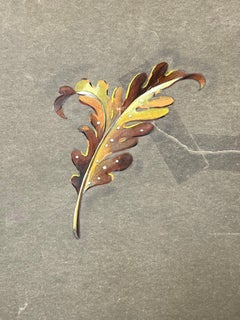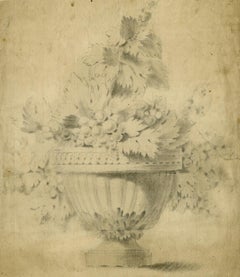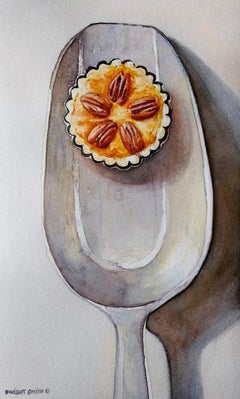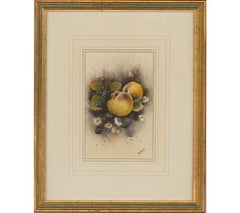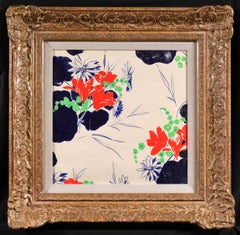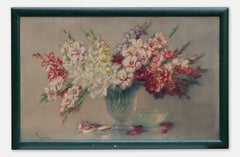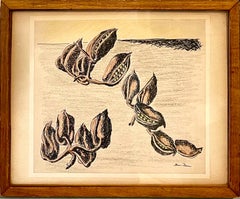Nut Still-life Drawings and Watercolors
to
1
4
Overall Width
to
Overall Height
to
1
1
2
1
4
76
553
527
374
268
231
204
191
184
139
133
118
103
95
90
80
76
63
51
51
3
3
2
1
1
1
1
2
2
Art Subject: Nut
Original Parisian Vintage Jewelry Design Art by Van Cleef & Boucheron Designer
Located in Cirencester, Gloucestershire
Golden Leaf Jewelry Design
circa mid 20th century
by Paul Touzet (French b. 1917)
original gouache painting, with pencil on tracing paper, unframed
overall design overall paper size...
Category
Mid-20th Century French School Still-life Drawings and Watercolors
Materials
Watercolor, Gouache, Pencil
Still life with ornamental urn, grapes and flora - French School 17 Cent.
Located in Middletown, NY
Pencil on cream laid paper, 10 x 8 3/4 inches (254 x 222 mm). Uniform age tone, scattered surface soiling, and handling wear. One pea-sized area of skinning in the top-center sheet ...
Category
Late 18th Century French School Still-life Drawings and Watercolors
Materials
Laid Paper, Pencil
Petite Treat, Original Painting
By Dwight Smith
Located in San Francisco, CA
Artist Comments
"My wife has been baking pecan pies for the holiday season," shares artist Dwight Smith," which inspired me to paint the still life. I love the warm colors of...
Category
21st Century and Contemporary American Realist Still-life Drawings and W...
Materials
Watercolor
Christopher Hughes - 20th Century Watercolour, Peaches and Blackberries
Located in Corsham, GB
A fine watercolour painting with gouache details by the British artist Christopher Hughes, depicting a still life of peaches and blackberries. Signed to the lower right-hand corner. ...
Category
21st Century and Contemporary Still-life Drawings and Watercolors
Materials
Watercolor
Related Items
Projet de Tissus - Fauvist Flowers Watercolor & Gouache by Raoul Dufy
By Raoul Dufy
Located in Marlow, Buckinghamshire
Botanical watercolour and gouache on paper circa 1920 by French fauvist painter Raoul Dufy. The work depicts flowers in red, blue and green. This work was executed by Dufy as a fabric design.
Dimensions:
Framed: 19.5"x19.5"
Unframed: 12"x12"
Provenance:
Private collection of works by Raoul Dufy for Bianchini Ferier
Bianchini Ferrier Collection - Christie's London - July 2001
SF Fall Show
Raoul Dufy was one of a family of nine children, including five sisters and a younger brother, Jean Dufy, also destined to become a painter. Their father was an accountant in the employ of a major company in Le Havre. The Dufy family was musically gifted: his father was an organist, as was his brother Léon, and his youngest brother Gaston was an accomplished flautist who later worked as a music critic in Paris. Raoul Dufy's studies were interrupted at the age of 14, when he had to contribute to the family income. He took a job with an importer of Brazilian coffee, but still found time from 1892 to attend evening courses in drawing and composition at the local college of fine arts under Charles Marie Lhullier, former teacher of Othon Friesz and Georges Braque. He spent his free time in museums, admiring the paintings of Eugène Boudin in Le Havre and The Justice of Trajan in Rouen. A municipal scholarship enabled him to leave for Paris in 1900, where he lodged initially with Othon Friesz. He was accepted by the École des Beaux-Arts, where he studied under Léon Bonnat, whose innate conservatism prompted Dufy to remark later that it was 'good to be at the Beaux-Arts providing one knew one could leave'.
And leave he did, four years later, embarking with friends and fellow students on the rounds of the major Paris galleries - Ambroise Vollard, Durand-Ruel, Eugène Blot and Berheim-Jeune. For Dufy and his contemporaries, Impressionism represented a rejection of sterile academism in favour of the open-air canvases of Manet, the light and bright colours of the Impressionists, and, beyond them, the daringly innovative work of Gauguin and Van Gogh, Seurat, Cézanne, Toulouse-Lautrec and others. Dufy was an out-and-out individualist, however, and was not tempted to imitate any of these artists. He produced, between 1935 and 1937, Fée Electricité (Spirit of Electricity), the emblem for the French utilities company Electricité de France (EDF).
Dufy visited the USA for the first time in 1937, as a member of the Carnegie Prize jury. In 1940, the outbreak of war (and his increasingly rheumatic condition) persuaded him to settle in Nice. When he eventually returned to Paris 10 years later, his rheumatism had become so debilitating that he immediately left for Boston to follow a course of pioneering anti-cortisone treatment. He continued working, however, spending time first in Harvard and then in New York City before moving to the drier climate of Tucson, Arizona. The cortisone treatment was by and large unsuccessful, although he did recover the use of his fingers. He returned to Paris in 1951 and decided to settle in Forcalquier, where the climate was more clement. Within a short time, however, he was wheelchair-bound. He died in Forcalquier in March 1953 and was buried in Cimiez.
Between 1895 and 1898, Raoul Dufy painted watercolours of landscapes near his native Le Havre and around Honfleur and Falaise. By the turn of the century, however, he was already painting certain subjects that were to become hallmarks of his work - flag-decked Parisian cityscapes, Normandy beaches teeming with visitors, regattas and the like, including one of his better-known early works, Landing Stage at Ste-Adresse. By 1905-1906 Friesz, Braque, Matisse, Derain, Vlaminck, Van Dongen and Rouault were described collectively as Fauves (the wild beasts). What they had in common was a desire to innovate, but they felt constrained nonetheless to meet formally to set out the guiding principles of what promised to be a new 'movement'. Dufy quickly established that those principles were acceptable; moreover, he was most impressed by one particular painting by Henri Matisse ( Luxury, Calm and Voluptuousness) which, to Dufy, embodied both novelty and a sense of artistic freedom. Dufy promptly aligned himself with the Fauves. Together with Albert Marquet in particular, he spent his time travelling the Normandy coast and painting views similar...
Category
1920s Fauvist Still-life Drawings and Watercolors
Materials
Paper, Watercolor, Gouache
Still Life with Flowers by Isidor Rosenstock
By Isidore Rosenstock
Located in Pasadena, CA
ISIDOR Rosenstock, born in Strasbourg in 1880, died in 1956. 20th century
painter of landscapes and flowers, watercolor.
He exhibited in Paris at the Salon of French Artists, the...
Category
Late 19th Century Impressionist Still-life Drawings and Watercolors
Materials
Gouache
Skull and Ornament - Vanitas, Still Life, Color Pencil Drawing, Framed
By John Hrehov
Located in Chicago, IL
Drawings of skulls are often called vanitas, which often contain collections of objects symbolic of the inevitability of death and the transience and vanity of earthly achievements and pleasures; it exhorts the viewer to consider mortality and to repent. This still life vanitas drawing is matted with a heavy white mat and framed in a bronze toned wooden frame measuring 15.75 x 16.25 inches.
John Hrehov
Skull and Ornament
colored pencil on paper
7h x 8w in
17.78h x 20.32w cm
JHR006
John Hrehov
Education
1985 MFA-Painting, University of Illinois at Urbana-Champaign
1981 BFA-Painting, Cleveland Institute of Art, Cleveland, OH.
Solo Exhibitions
2017 John Hrehov, Paintings and Drawings. Tom Thomas...
Category
2010s Surrealist Still-life Drawings and Watercolors
Materials
Archival Paper, Color Pencil
Gun from Clue
By A.J. Fries
Located in Buffalo, NY
An original mixed media drawing by American artist A.J. Fries.
Category
21st Century and Contemporary Realist Figurative Drawings and Watercolors
Materials
Gouache, Graphite, Paper
Botanical Studies, Watercolours on Silk on Handmade Paper, Set of Three Tulips.
Located in Cotignac, FR
A set of three fine hand painted botanical watercolour studies on silk of tulips by La Roche Laffitte. The works are signed bottom right. Some are titled and numbered (see photos) Th...
Category
Late 20th Century Still-life Paintings
Materials
Watercolor, Gouache, Handmade Paper, Silk
H 21.19 in W 15.16 in D 0.04 in
Homage to Chanel - 4" x 6", Original Artwork, Black And White, Blue
Located in Mississauga, Ontario
An homage to the iconic Chanel No. 5 perfume. Textured elements add visual interest to this mixed media artwork on board. With delicate detail, this piece combines paint, pencil and ...
Category
2010s Contemporary Still-life Drawings and Watercolors
Materials
Mixed Media, Acrylic, Pencil, Paper
Chrysanthemums and Tiger Lilies
Located in Fairlawn, OH
Chrysanthemums and Tiger Lilies
Signed and dated lower left (twice), see photo
Watercolor on paper, 1935
A symbol of the sun, the Japanese consider the or...
Category
1930s Realist Drawings and Watercolor Paintings
Materials
Watercolor
Original 70's Hand Painted Textile Design Gouache Navy Blue Color on White Paper
Located in ALCOY/ALCOI, ES
Compass Rose and Flower design. Sealed on the back with the design studio name and number 397
We offer a small number of these original illustration designs by this design studio ba...
Category
1970s Modern Still-life Drawings and Watercolors
Materials
Paper, Gouache
H 34.65 in W 18.9 in D 0.12 in
French Gouache & Watercolour, Still-Life of Roses in a Confit Jarre.
Located in Cotignac, FR
A beautiful fresh and lively original French gouache and watercolour of a still-life of roses in a Provençal 'confit jarre'. Signed Jocelyn to the lower right. The work is currently ...
Category
Mid-20th Century Still-life Paintings
Materials
Paper, Watercolor, Gouache
Franklin Adams (New Orleans) "Camisole" - Modern Graphite Sketch Drawing
Located in New Orleans, LA
(Photographed behind the glass of the frame, so please pardon reflections.) As you can see from the receipt, this fine drawing was originally purchased for $3,500 on Julia Row in New Orleans. A New Orleans legend, Franklin Adams moved to the city in 1958 to teach painting and drawing at Newcomb College. Over the following years, he applied his wide-ranging talents to architecture, set design, logo design and other diverse projects. He was good friends with Mignon Faget...
Category
1990s Realist Figurative Drawings and Watercolors
Materials
Graphite
Botanical Studies, Pair of Watercolours on Silk on Handmade Paper, Anemones
Located in Cotignac, FR
A pair of fine hand painted botanical watercolour studies on silk of anemones by La Roche Laffitte. The works are signed bottom right. Both are titled. The silk has been mounted on h...
Category
Late 20th Century Still-life Paintings
Materials
Silk, Watercolor, Handmade Paper, Gouache
H 21.26 in W 15.56 in D 0.04 in
Rambling Rose, Jo Haran, Contemporary Floral Artwork, Original Work On Paper
By Jo Haran
Located in Deddington, GB
Rambling Rose by Jo Haran [2020]
original
Gouache, watercolour ink and gesso.
Image size: H:72.5 cm x W:52.5 cm
Complete Size of Unframed Work: H:76 cm ...
Category
21st Century and Contemporary Contemporary Still-life Drawings and Water...
Materials
Gesso, Paper, Watercolor, Gouache
Previously Available Items
Expressionist Ink, Pastel, Crayon Drawing Jewish American Modernist Ben Zion WPA
Located in Surfside, FL
Expressionist ink and pastel crayon drawing of beans (carobs, flowers?) in pods
Hand signed.
Born in 1897, Ben-Zion Weinman celebrated his European Jewish heritage in his visual works as a sculptor, painter, and printmaker. Influenced by Spinoza, Knut Hamsun, and Wladyslaw Reymont, as well as Hebrew literature, Ben-Zion wrote poetry and essays that, like his visual work, attempt to reveal the deep “connection between man and the divine, and between man and earth.” An emigrant from the Ukraine, he came to the US in 1920. He wrote fairy tales and poems in Hebrew under the name Benzion Weinman, but when he began painting he dropped his last name and hyphenated his first, saying an artist needed only one name.
Ben-Zion was a founding member of “The Ten: An Independent Group” The Ten” a 1930’s avant-garde group, Painted on anything handy. Ben-Zion often used cabinet doors (panels) in his work. Other members of group included Ilya Bolotowsky, Lee Gatch, Adolph Gottlieb, Louis Harris, Yankel Kufeld, Marcus Rothkowitz (later known as Mark Rothko), Louis Schanker, and Joseph Solman. The Art of “The Ten” was generally described as expressionist, as this style offered the best link between modernism and social art. Their exhibition at the Mercury Gallery in New York held at the same time as the Whitney Annual Exhibition of Contemporary American Painting, included a manifesto concentrating on aesthetic questions and criticisms of the conservative definition of modern art imposed by the Whitney. Ben-Zion’s work was quickly noticed. The New York Sun said he painted “furiously” and called him “the farthest along of the lot.” And the triptych, “The Glory of War,” was described by Art News as “resounding.”
By 1939, The Ten disbanded because most of the members found individual galleries to represent their work. Ben-Zion had his first one-man show at the Artist’s Gallery in Greenwich Village and J.B. Neumann, the highly esteemed European art dealer who introduced Paul Klee, (among others) to America, purchased several of Ben-Zion’s drawings. Curt Valentin, another well-known dealer, exhibited groups of his drawings and undertook the printing of four portfolios of etchings, each composed of Ben-Zion’s biblical themes. He worked as a WPA artist.
Ben-Zion’s work is represented in many museums throughout the country including the Metropolitan, the Whitney, and the Museum of Modern Art in New York, the Art Institute of Chicago, the Philadelphia Museum of Art and the Phillips Collection, Washington. The Jewish Museum in New York opened in 1948 with a Ben-Zion exhibition.
Ben-Zion consistently threaded certain subject matter—nature, still life, the human figure, the Hebrew Bible, and the Jewish people—into his work throughout his life. "In all his work a profound human feeling remains. Sea and sky, even sheaves of wheat acquire a monolithic beauty and simplicity which delineates the transient as a reflection of the eternal. This sensitive inter- mingling of the physical and metaphysical is one of the most enduring features of Ben-Zion's works." (Excerpt from Stephen Kayser, “Biblical Paintings,” The Jewish Museum Catalogue, 1952). Mystical Imprints: Marc Chagall, Ben-Zion, and Ben Shahn presents the print work of three prominent 20th century Jewish artists born in the Russian Empire. Among these seventy pieces are etchings and lithographs from Chagall’s Bible series...
Category
Mid-20th Century Expressionist Still-life Drawings and Watercolors
Materials
Paper, Oil Crayon, Pastel, Ink
